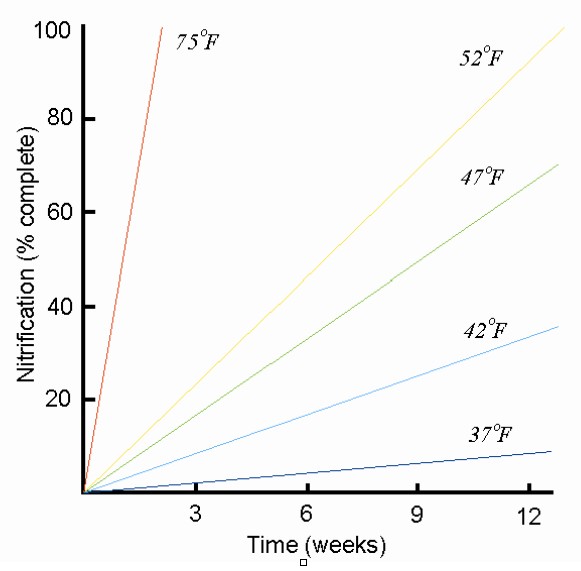Nitrogen loss in saturated soils
____________________________________________________

Heavy rainfall in central Nebraska last week has caused crop producers to
question the availability of nitrogen (N) fertilizer applied this spring and
with good reason. Some fields may have experienced significant nitrogen
loss. There are several factors which will influence the amount of loss,
including rainfall amount and intensity, soil texture, soil temperature,
fertilizer source and application date. Loss pathways can include runoff,
denitrification and leaching.
Figure 1. Estimated nitrification over time.
Runoff
If fertilizer had been recently applied to the soil surface, without
incorporation or a gentle rain of 0.5 inch or more to move nitrogen into the
soil profile, substantial nitrogen loss may occur in runoff. Rainfall was
very intense in some areas last week, with total precipitation exceeding 10
inches in some areas, resulting in severe erosion and loss of nutrients on
or near the soil surface.
Denitrification
The primary nitrogen loss mechanism from saturated, fine-textured soils may
be denitrification. This is the process of anaerobic bacteria present in
soil converting nitrate-N into gaseous forms (nitric oxide, nitrous oxide,
dinitrogen) which can be lost to the atmosphere. In fields where most
fertilizer nitrogen was applied preplant, likely four to eight weeks ago,
much of the N may have been converted to nitrate by the microbial process of
nitrification. This nitrate is then susceptible to loss via denitrification
or leaching.
Leaching
If nitrogen existed in soil in the nitrate or urea forms, significant
leaching loss may have occurred, more so on coarse-textured soils. Some of
this nitrogen may have leached deep enough into the root zone to be
unavailable to the crop, at least early in the season. Continued
precipitation or irrigation may leach this nitrogen out of the root zone
entirely.
For more information on soil processes influencing nitrogen management, view
the Nitrogen Chapter of the Cooperative Extension publication, Nutrient
Management for Agronomic Crops in Nebraska.
| Table 1. Potential field loss of nitrogen, depending on temperature and time since application |
Time |
Temperature |
N Loss |
(days) |
(degrees F) |
(percent) |
------------------------------------------------------------------- |
5 |
55–60 |
10 |
10 |
55–60 |
25 |
3 |
75–80 |
60 |
------------------------------------------------------------------- |
| Denitrification loss will be less with soils having less than 1% organic matter. |
Management options
Unfortunately, there are many variables interacting to influence the
potential for nitrogen loss from heavy rainfall, making it difficult to
estimate how much fertilizer N has been lost, and whether producers should
apply more fertilizer. Figure 1 and Table 1 can be used to help derive rough
estimates of potential loss. For anhydrous ammonia applied 6 weeks ago,
perhaps at least 50% of the nitrogen has been converted to nitrate. If soils
have remained saturated for a week, perhaps 10-20% of the nitrate nitrogen
has been lost to denitrification, with additional loss due to runoff or
leaching. Whether remaining nitrogen will be adequate to optimize yield
potential depends on the initial application rate, and growing conditions
during the rest of the season.
Soil sampling is one option to evaluate what is left, but results may be
difficult to interpret. If nitrogen fertilizer has been banded, many samples
will be required to integrate what the plant will have access to. Samples
should be collected to a depth of three feet in one foot increments.
Consider having samples analyzed for ammonium as well as nitrate, since
substantial nitrogen from many fertilizer sources may remain in the ammonium
form. Interpretation of soil test results for both ammonium and nitrate may
require help from a soil scientist. Even then accurate prediction of
fertilizer nitrogen availability will be difficult.
If producers can sidedress nitrogen or apply it through an irrigation
system, they may want to supplement loss they believe may have occurred. The
challenge will be to know what rate to apply. Over-fertilization will
increase the cost of production and potentially increase the loss of
nitrogen to the environment, while under-fertilization will reduce yield.
Carefully monitoring the crop for N status may be the best option, primarily
between now and silking, especially if producers have the option to
sidedress, fertigate or apply nitrogen with high clearance equipment. Most
corn hybrids will take up the majority of their nitrogen requirement in this
period. Visual observation for signs of nitrogen deficiency (lower leaves
yellowing, inverted "V" yellowing pattern of leaf tips) is one option,
although yield potential may be reduced by the time nitrogen deficiency is
visually evident. A chlorophyll meter may be useful in detecting nitrogen
stress before it can be seen. To calibrate chlorophyll meter readings, it is
best to have one or more strips in the field with nitrogen applied at a rate
high enough to be non-yield limiting to serve as a reference. For more
information on the use of a chlorophyll meter to manage nitrogen, see
NebGuide 1171, Using a Chlorophyll Meter to Improve N Management.
Richard B. Ferguson
Extension Soils Specialist
